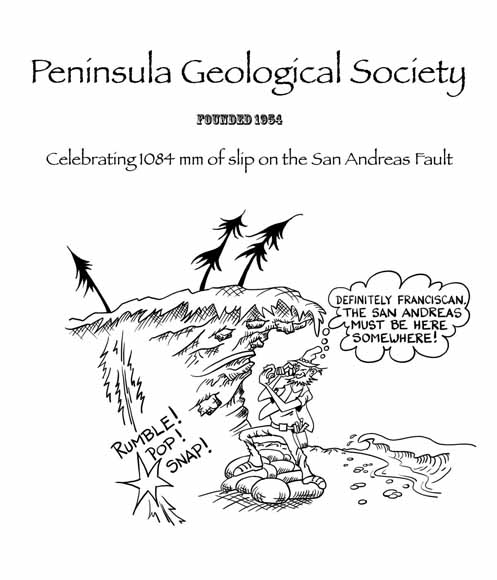
Presents
Location: Stanford University
This will be the 448th meeting since 1954

To show the spectacular tectonic geomorphology at this location, this photo show the trace of the Mission Creek fault strand looking northwest. The Palm trees show the trace of the fault and highlighted in dark blue is the present-day capture of Pushawalla Canyon. Here you can see the beheaded channel 3, 2 and 1. Photo by Kate Scharer
To understand the processes and mechanisms driving fault growth and crustal deformation it is essential to characterize the mechanical behavior and interactions of faults across a system and their fluctuations through time. Geologic slip rates along individual fault strands, across fault zones, and entire fault systems provide critical information on these aspects of crustal deformation and on the recurrence of past earthquakes. This seminar presents new geomorphologic, neotectonic, and geochronologic data that constrains Quaternary fault slip rates for the southern San Andreas fault system in California (comprising the San Andreas, San Jacinto, and Elsinore fault zones), with important implications for seismic hazard in the region. Although the potential for a large magnitude earthquake on the southern San Andreas fault zone is clearly high, the amount of slip accommodated by its individual fault strands is poorly constrained. The Mission Creek fault strand of the San Andreas fault zone in the central Indio Hills has generally been considered subordinate, but new slip rate estimates, based on Uranium-series dating of pedogenic carbonate and 10Be cosmogenic exposure age dating of Quaternary deposits with well-preserved fault displacements over three different time intervals, indicate an unexpectedly high and constant slip rate of 22-25 mm/yr over the past ~100 kyr. Combined with published paleoseismic studies for the Mission Creek fault strand, which show an average earthquake recurrence interval of 225 years for the past 5 events since 900 AD, this implies an average slip per event of ~4.5 m. As the last earthquake to rupture this section of the Mission Creek fault strand occurred over 300 years ago (ca. 1690), these results indicate ca. 6.0 to 7.5 m of strain accumulation, and a significant potential for a large magnitude earthquake along this fault strand.

Kim Blisniuk
Kimberly Blisniuk is starting in her new faculty position at San José State University in January (congratulations!) and is presently a Visiting Scholar at Stanford University. She was an NSF Earth Science Postdoctoral Fellow, a Postdoctoral Fellow at the U.C. Berkeley/Berkeley Geochronology Center, and in 2013, received the Kurt Frankel award from NCALM in recognition of creative and innovative research applying airborne LiDAR and other data in tectonic geomorphology. Her education includes University of California, Davis (Ph.D. in Geology, 2011, Central Washington University (M.S. in Geology, 2004), and University of California, Riverside (B.S. in Geology, 2000). She is a field geologist and geochronologist interested in neotectonics, earthquake geology, and tectonic reconstructions of dynamic processes in the upper crust. She is particularly interested in how crustal deformation at depth is manifested at the surface both temporally and spatially, as this information is critical for understanding regional tectonics as well as kinematic and mechanical models of crustal deformation. Her research implements a variety of field and laboratory tools aimed at characterizing the geometric evolution and rates of faulting in tectonically active landscapes. These tools include geochronology (specifically terrestrial cosmogenic radionuclides and U-series dating), structural and geomorphic mapping, the analysis of high-resolution topography data, GIS, and the application of mechanical models to simulate the behavior of the structures observed in the field.
Reservations: The preferred way to make reservations is simply to email Mike Diggles at mdiggles@usgs.gov by Nov. 9, tell him you will attend, commit to pay, and bring your payment to the meeting. Mike always emails a confirmation; if you don’t get one, assume email crashed yet again and email him a second time. A check made to “PGS” is preferred, payable at the meeting.
If you want to pay in advance:
Everyone (including Stanford folks now) Please make dinner reservations by Nov. 9. Contact Mike Diggles, at U.S. Geological Survey, 345 Middlefield Road, MS-910 Menlo Park, CA 94025, Tel.: (650) 329-5404. Send check made out to “PGS” to Mike.
Dinner and the social hour is $35.00; this includes $5 that we use to help pay for students who are only $8.00 (also partially subsidized thanks to the School of Earth Sciences, Stanford University (Note, no-show reservations owe the full price).
Doris, whose wonderful crew prepares our meals, asked that we let you know that people who are late RSVPing and people who show up without a reservation will be welcome but that they may be eating on paper plates with plastic utensils (food supply permitting).
Dues for Academic Year 2014-2015 ($10.00) should be sent to Mike Diggles, U.S. Geological Survey, 345 Middlefield Road, MS-910, Menlo Park, CA 94025. Mike’s phone: (650) 329-5404.
Officers: Brad Buerer, President; Sarah Nagorsen, Vice President; Mike Diggles, Secretary-Treasurer; Elizabeth Miller, PGS Stanford University Coordinator


PGS cartoon by Rick Blakely
Date created: October 27, 2014
Last modified: October 29, 2014
Created by: Mike Diggles, Webmaster-Secretary-Treasurer, PGS.